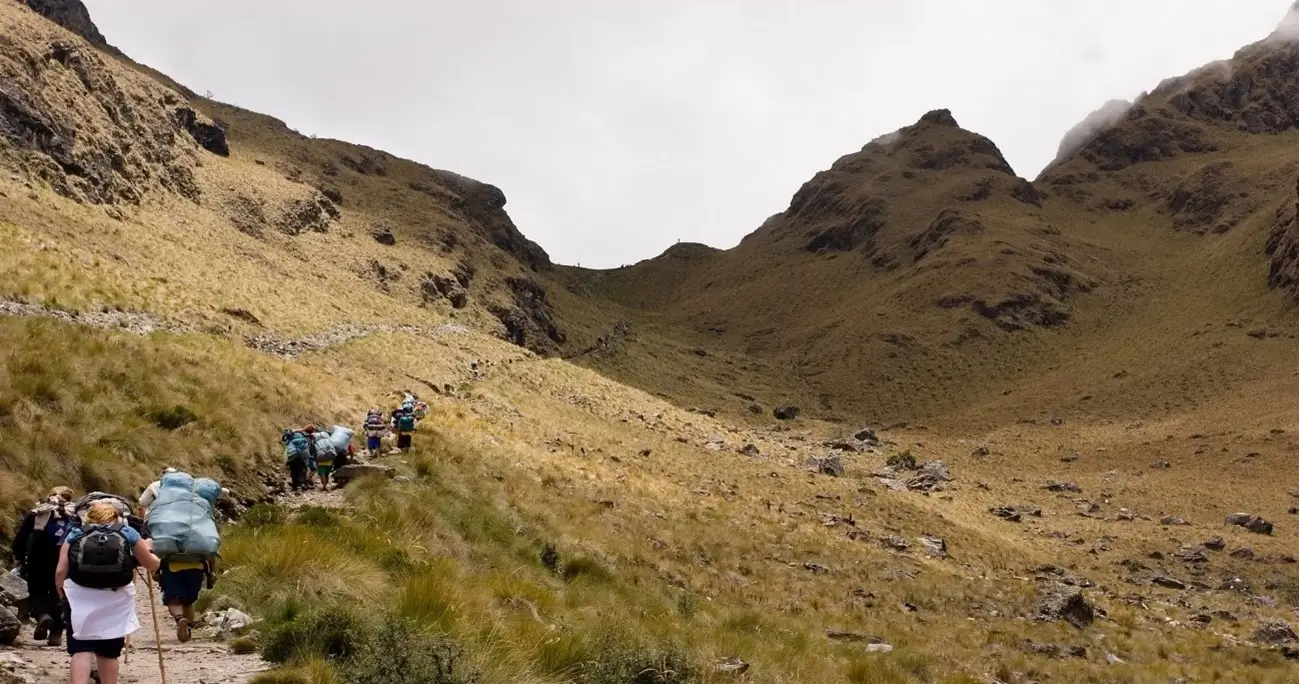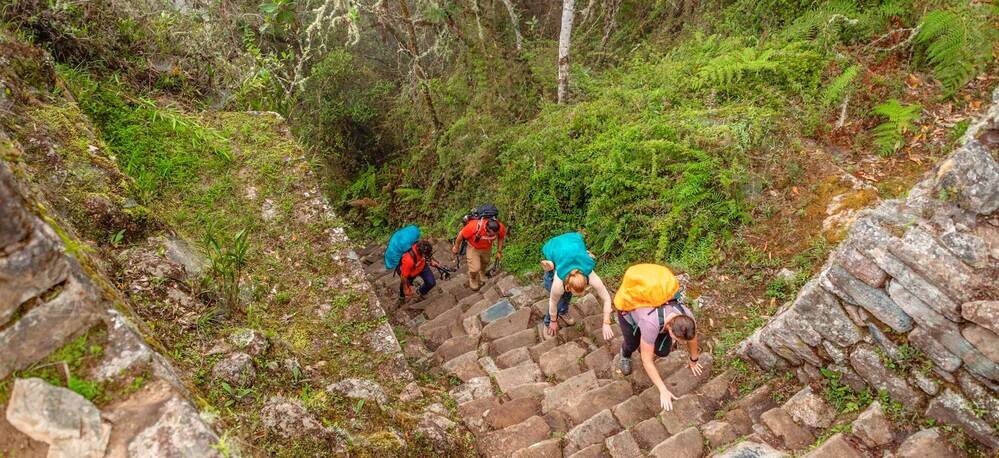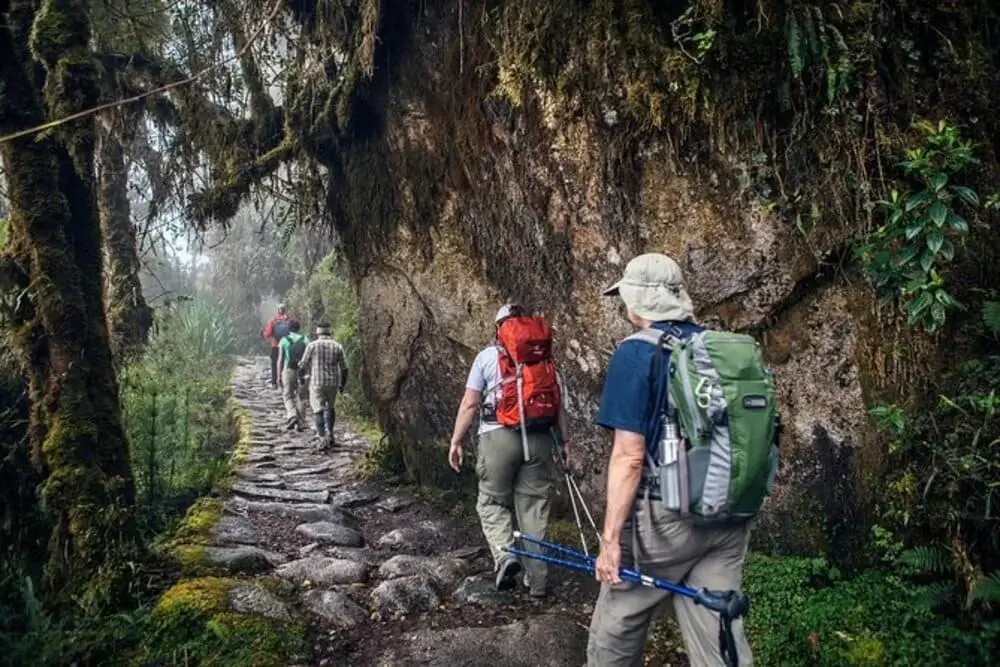Whether hiking on the Inca Trail or not, you will be fascinated by the history of this mythical Andean road.
The Inca Trail is a 42 km path that winds through the Peruvian Andes. It is not only a physical journey but also a significant historical and cultural odyssey. Stretching from the Sacred Valley to the magnificent ruins of Machu Picchu, it was a central route for Inca religious, political, and economic activity. It remains a vivid legacy of the spiritual, cultural, and historical heritage of the Incan Empire.
Inca Trail: History, Origins & Cultural Significance
Ancient Pathways: The Inca Trail’s Origins and Significance
The Inca Trail, stretching across the Andes, stands as a marvel of ancient engineering. Its origins remain wrapped in history and legend. Crafted by the Inca civilization, the trail showcased their mastery over the rugged terrain.
This historic pathway once facilitated rapid communication between distant parts of the empire. Couriers, known as “chaskis,” ran relay-style, delivering messages and goods. The Inca Trail also played a spiritual role, connecting sacred sites and temples.
Interestingly, the trail is not a singular path but a vast network. Spanning thousands of kilometers, it linked modern-day Colombia, Ecuador, Peru, Bolivia, Chile, and Argentina. Each segment holds unique stories and significant insights into the daily life and rituals of the Incas.
While the trail unveils majestic ruins and landscapes, it also hints at deeper cultural elements. Ayahuasca rituals, for instance, offer a window into the spiritual practices of the region’s inhabitants. These ceremonies, dating back centuries, highlight a profound connection between humans, nature, and the cosmos.
Adventures in Manu provide another layer of richness to the region’s tapestry. Just a journey away, they offer glimpses of biodiversity and traditions running parallel to the Inca Trail’s history.
Today, the Inca Trail stands not just as a hiking path but as a bridge to the past. Every step on this trail echoes with tales of conquests, ceremonies, and daily life. For travelers, the Inca Trail is more than a trek; it’s an immersive historical experience.
Why Was the Inca Trail Built?
Unlike other roads, the Inca Trail to Machu Picchu had a spiritual and ceremonial purpose. Historians believe it was:
- A pilgrimage route used by priests and nobles to reach Machu Picchu.
- A sacred path aligned with the movements of the sun and stars.
- A means of connecting temples, shrines, and settlements hidden in the Andes.
Stones and Stories: Unearthing Archaeological Wonders Along the Way
Beyond its breathtaking landscapes, the Inca Trail harbors hidden archaeological treasures. Each site tells a distinct story of the Inca civilization. Winding through mountains and valleys, the trail unfolds tales of ancient ambition and spirituality.
Walking the trail, trekkers encounter sites like Patallacta, an ancient town that once thrived as a ceremonial and agricultural hub. Further on, Runkurakay captures imaginations with its semi-circular structure. Historians believe this site functioned as a tambo, offering rest and refuge for travelers.
Wiñay Wayna is another marvel. Built into a steep hillside, this site showcases the Incas’ agricultural genius. Their architectural ingenuity becomes evident, demonstrating their deep understanding of the land. Finally, the trek culminates at Machu Picchu, the crowning jewel of the Inca heritage. This citadel remains a testament to their cultural and engineering prowess.
Beyond the Inca Trail, trekking through Manu offers additional historical insights. Experiential tourism in Manu provides another perspective, focusing on living traditions and the natural wonders of the area.
In essence, the Inca Trail is a living museum. Its stones whisper stories of rituals, battles, and daily life. The allure lies not just in the physical journey but in the voyage through time. Every step deepens the understanding of a civilization that once ruled the Andes.
For those captivated by the past, the Inca Trail offers an unforgettable journey. But remember, the entire region beckons with its mysteries. Explore, and let the stories of ancient Peru unfold before you.
Key Ruins Along the Trail
🏛 Patallacta – Ancient agricultural terraces with stunning valley views.
🏛 Runkurakay – A mysterious circular Inca outpost.
🏛 Sayacmarca – The "Inaccessible Town," perched on a cliff.
🏛 Wiñay Wayna – "Forever Young," a breathtaking ruin near Machu Picchu.
🏛 Inti Punku (Sun Gate) – Your first magical view of Machu Picchu at sunrise.
Origins of the Inca Trail: The Qhapaq Ñan
The Inca Trail is just one part of a vast road network known as the Qhapaq Ñan (The Great Inca Road), an intricate system of over 39,000 km (24,000 miles) that connected the Inca Empire, from present-day Colombia and Ecuador in the north to Chile and Argentina in the south.
The Purpose of the Inca Road System
The Qhapaq Ñan was not just a network of roads, it was the lifeline of the empire. The Incas, despite not having the wheel or horses, built these roads to:
- Ensure efficient communication between distant regions.
- Facilitate trade and transport of food, textiles, and goods.
- Allow for military mobilization to defend and expand the empire.
- Enable religious pilgrimages, particularly to sacred sites like Machu Picchu.
- One of the most sacred branches of this road network was what we now call the Inca Trail, leading to the hidden city of Machu Picchu.
How Was the Inca Trail Built?
The Incas, without modern tools or written blueprints, constructed an incredibly durable road system that has lasted over 500 years.
Materials & Techniques
- The trail was built using locally available stone, carefully carved and fitted together.
- In steeper areas, they created stone staircases and terraces to prevent erosion.
- They developed advanced drainage systems to prevent flooding, using gravel and layers of stone to stabilize paths.
- In some areas, rope bridges made from woven plant fibers allowed for safe river crossings.
Adaptation to Nature
- Instead of cutting straight through mountains, the Incas followed the natural contours of the landscape.
- They used switchback designs to reduce the steepness of trails, making it easier for travelers and llama caravans.
- The trail blends so seamlessly with its environment that it remains a part of the natural world, rather than an intrusion.
- Even today, modern engineers marvel at the durability and foresight of Inca construction methods.
- Read our blog on The Best Hikes in Peru or Inca Trail Tips & Insights
The Inca Trail is more than just a trek it’s a journey into history, nature, and self-discovery. As you ascend ancient stone paths, cross misty mountain passes, and explore the ruins of a lost civilization, you'll feel the presence of the Inca Empire all around you. The reward? A breathtaking sunrise over Machu Picchu, an unforgettable moment that few travelers experience in such a profound way.
This is not just a hike; it’s a story waiting to be lived. Whether you're an adventurer seeking challenge, a history lover drawn to the mysteries of the past, or a family looking for a once-in-a-lifetime experience, the Inca
Are you ready to follow in the footsteps of the Incas? Let Andean Travel Experience take you there.



